In the afternoon of August 27, 2008, on our institute research professor Zhongpin Lai′s invitation, Hucai Zhang, Shijie Li, research professors of institute of Nanjing Geography and Lakes Chinese Academic of Science(NIGLAS), and Chunhai Li, associate professor of NIGLAS, came to our institute to deliver academic  reports.
reports.
Hucai Zhang is an advisor of Ph. D. student of NIGLAS now. In recent years, he developed the studies on the variations of west China and plateau lakes of Yunnan, physiognomy and environment of Yangtze River. His main work published on international journals of Geophysical Research Letters, Quaternary Research, Palaeogeography Palaeoclimatology Palaeoecology, Radiocarbon, and Chinese Science Bulletin. His report topic is: the question in lacustrine deposit chronology research. Mr. Zhang had demonstrated his massive findings of C-14 dating study on the deposits of lakes in Tenggeli and Badanjilin desert, Ejina and Qaidam Basin. He also discussed the Environmental meaning of Chronology findings in detail. Finally, Mr. Zhang concluded that because the strong influence of Old carbon and the dissolved substances on the deposits of lakes in the drought areas, its C-14 dating shows a great deal of uncertainty, and sometimes even cannot represent the age of the sediment deposition. The uncertainty of the dating results of samples not only rooted in their own elements (isotopes) and the characteristics of the sediments in the process of re-sedimentation, but may also rooted in the impact of radiation derived from the C-14 production instability. Therefore, he pointed out that a number of dating ways must be integrated to make out a more reliable formation age of the sample.
Mr. Li′s field is lake deposition and Quaternary Period environmental variation. His academic report topic is the lake deposition and environment variations of Qinghai-Tibet Plateau. With the observation data on lakes and weather, he showed the ecological and environmental changes of Qinghai-Tibet Plateau lakes at the context of global warming. He indicated that some of the lakes are experiencing the ecologic and environment deterioration of the process of evolvement from lakes to swamp, from swamp to grassland, and then to deserts. After that, with the C-14 dating and multi-analysis data of Tibetan Zigetang-cuo lake sediments, he reconstructed the weather and environment change situations since Holocene of this area.
Associate professor Li is mainly engaged in the spore  powder and the Quaternary Period environmental variation study. His academic report topic is: the combination of Shell dike pollen and changes in the environment. Mr. Li pollen analyzed the Qaerhan ancient shell dike section plane′s deposit of Qaidam Basin, and the findings show that the vegetation and climates had experienced several changes at mid and late Pleistocene Epoch stage. According to the shell dike entire section plane analysis, he believed that the main terrestrial pollen plants are the gramineae, Tamarix, Zygophyllaceae, ephedra, Pinus, Picea, Cupressaceae etc. Artemisia and Chenopodiaceae are a fat lot. This is completely different with the soil analysis of eastern part of Qaidam Basin, and also different with result of surface soil pollen of other deserts and Wilderness prairies. This indicated that vegetations of late Pleistocene Epoch of eastern Qaidam Basin cannot be compared with that of today, and the climate was also remarkable different.
powder and the Quaternary Period environmental variation study. His academic report topic is: the combination of Shell dike pollen and changes in the environment. Mr. Li pollen analyzed the Qaerhan ancient shell dike section plane′s deposit of Qaidam Basin, and the findings show that the vegetation and climates had experienced several changes at mid and late Pleistocene Epoch stage. According to the shell dike entire section plane analysis, he believed that the main terrestrial pollen plants are the gramineae, Tamarix, Zygophyllaceae, ephedra, Pinus, Picea, Cupressaceae etc. Artemisia and Chenopodiaceae are a fat lot. This is completely different with the soil analysis of eastern part of Qaidam Basin, and also different with result of surface soil pollen of other deserts and Wilderness prairies. This indicated that vegetations of late Pleistocene Epoch of eastern Qaidam Basin cannot be compared with that of today, and the climate was also remarkable different.
